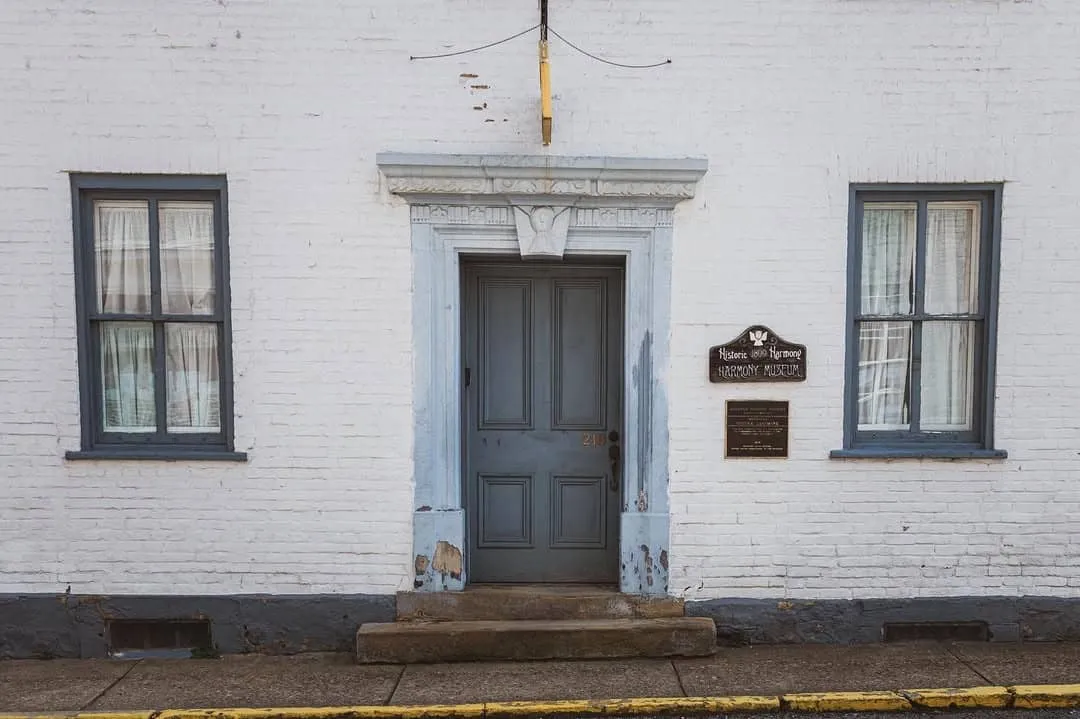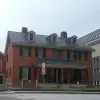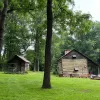
The museum is operated by Historic Harmony, Inc., which was established in 1943.
Harmonist Room
This is a period setting depicting the living style of the Harmonists. The room contains most of the museum's Harmonist furniture in its collection. The table is Harmonist. Each family was given a similar work table for use in their kitchen. There are drawers on the side for extra storage space, and the top is removable. The tall case clock is also a Harmonist and is still in working condition. The paint is original - they often used blue and gold colors. The bed is Harmonist, and it has a rope to hold the two mattresses. The coverlet was handwoven in Harmony by Adam Hoerr in 1842. Most weavers signed their work by weaving their name, date, and town in a corner. The rocking chair and the chair by the table are Schantz chairs. After the Harmony Short Line Railroad folded, Mr. Elmer Schantz was unemployed and started a chair-making business. The seat is woven of white oak splints, which he made using a schnitzelbank.
The houses here were originally built for families, so the women slept downstairs when they decided to be celibate. When they moved to Indiana, they built dormitories so the men and women were separate and only ate and worked together. In the Economy, the community set up living quarters similar to these
Fireplaces originally heated these houses. Later, stoves similar to this 10-plate stove were installed. It is called a 10-plate stove because it consists of 10 sections, or plates, that are bolted together. It was often used to heat bedrooms and living rooms, while the flat surface on top could heat a pan of water.In this case, the museum has Harmonist items. They were famous for manufacturing wine and whiskey, which they sold. The glass bottles and labels are from Economy. Here, they sold the wine and whiskey in wooden kegs and barrels. They were also famous for woolen material, selling for $10 a year. The material was in demand because people realized the quality of Harmonist wool, and there was always a market for it. They had over 3,000 sheep here at one time and began acquiring the Merino breed of sheep (originally from Spain) because of the high quality of fibers that the animals produced. Later, while at the Economy, the Society invested in lumber and oil and became wealthy. The granddaughter, Gertrude, studied silk worms, and in the Economy, the Harmonists established a silk industry that became well known. While here they only manufactured woolen material.
The Kitchen
The kitchen represents a hundred-year span from 1800 to 1900. Some items are Harmonist, some are similar to what they used, and a few represent that period. The stove is not a Harmonist. They cooked in fireplaces and baked in outside community ovens. The wood-burning stove is a Sears Roebuck model from the late 1800s. Museum staff think it costs around $20.00 when it is new. On the right is what's called a "water reservoir". IF you kept wood burning, you'd have hot water on the side. There's another Harmoist table with drawers. The utensils are also Harmonist. One has a bone handle. The apple peeler still works. The museum has three butter churns. The barrel type is most common. The rocking (or swing) type was more straightforward because you could sit down and rock it. The one with a pump handle is the oldest and works like a water pump. The handle is moved up and down, and the cream gets churned into butter in the large box. The other item with a handle is a sausage stuffer. The casing would go on the spout, and ground meat would be pushed into it. You tied off the length you wanted for your sausages. The sink is Harmonist. The right part is stone, and there would be a small hole in the wall where the section is cut out to allow the water to be channeled.
In this case, it is a butter mold collection. The wood items are the molds, and the yellow plaster represents the butter as it came out. Each family had their own design, and most symbols are from the Bible. On the other side of the wall is a photograph of a painting of Father Rapp. On the creek, there were 137 steps up the side bank. A natural chair formed at the top of a rock where Father Rapp spent his day meditating, reading the Bible, and overseeing the field workers. There is only one surviving image of Father Rapp. It was painted on a piece of wood by a man from western N.Y. state and now the painting is housed at Old Economy.Hall
The rifles are not from the Harmony Society. Museum staff think they did use guns for hunting food, but they were pacifists and paid their men to be exempt from the War of 1812, which was going on while they were here. This made hard feelings with the neighbors whose husbands and fathers had to fight and possibly die for the American cause, and these people didn't. That was one reason they left the area (in 1814), but also the soil here wasn't as good for grape growing as they had hoped, and water transportation wasn't very close. Mostly, the rifles were made or owned by people here in Harmony in the late 1800s.
Some religions at the time frowned upon music, but this particular sect enjoyed singing and even encouraged people to write new songs. They mostly sang hymns while they worked, but they also had a few instruments so that they could play for visitors or just for their own enjoyment in the evening.
In the case in the hall are photographs of the Harmonist architectural style. The buildings use a style called Flemish bond (every 6th row, the bricks are put in the long way) for strength. The roofs originally were all very steep, as in Germany, so the snow would fall off. But in the 1850s, a tornado took off most of the roofs in town, and then they were rebuilt at a lower American angle. The museum building is one of the few left with the original pitch. The European look of the village was lost when the roofs were lowered. The roofs originally were thatch, and later, slate was put on.On the wall, the museum has a copy of the original deed written on sheepskin in 1814 when Father Rapp sold all the land and buildings to Abraham Ziegler for $100,000. Ziegler and his group were Mennonites from easten Pennsylvania.
Wine Cellar
This wall was originally the outside of the Harmonist building. The arch was open wider at one time. The addition was put on when this was a girls' school. Most recently, the fire department had its trucks in here. Three years ago, the Association purchased the whole building. With the help of state grants, the museum renovated the room. The steps to the wine cellar are uneven. Please use the handrail and be careful when you descend.
The cellar is built with an arch, like most German wine cellars. A keystone goes through the center and holds the arch together. The windows are open for circulation. The temperature is always between 50° and 65° year-round. That was the ideal temperature for storing the wine. The floor is sandstone. The pieces were cut and numbered out in the quarry. When they brought them here, they matched them up like a jigsaw puzzle so it would fit as tightly as possible. A section is indented on purpose so that a barrel might stop rolling if it gets to that area. The "hole" is a spring. It's been filled in for safety purposes. When it rains, water seeps up from underground. It usually just comes to the top and then evaporates. At one time, when this was a family house and before they had refrigerators, they would float a board on the water and could keep their butter and milk cool in the area.Here are some postcards from New Harmony, Ind., the second home of the Harmonists, and also postcards from Old Economy, the third home. One postcard shows the boy's dormitory. Another shows the labyrinth or maze garden. The Harmonists had these at all three locations. The museum doesn't have gardens here, but New Harmony maintains the garden there. In the maze, the objective was to reach the center.
The History Room
The cut-out section of the wall shows the building insulation. The insulation is called "Dutch Biscuit," which consists of mud and straw. Also, people at that time made their own glass and windows. It has slight bubbles and ripples. The mounted item is a section of a wooden water pipe from the period.
In this case, the museum has a Pennsylvania rifle, like the one Daniel Boone used. It was made by two brothers here in Harmony. It belonged to Doc Stewart, a recent physician who died 15 years ago at 98. He helped get the museum started, and he requested that this gun be left out of a closed case so that children could see it better. There's a ramrod and a special pocket for the wadding.Next, the museum has the Ziegler family tree. It starts with Abraham, who was born in 1774. His first wife died, and he remarried. Between the two women, there were 15 children. Each arch represents 25 years. There are several Zieglers still in the area. One lady keeps the genealogy up to date and sells books to interested family members and others.
In the corner is a typical Mennonite sitting room. It depicts a plain and simple lifestyle. The portrait is of Abraham, and the others are his grandson, Abraham the Third, and his wife. Although it's another group now, their ancestors were also from Germany, so they took over the same professions left by Rapp and the Harmonists: weavers, wine growers, and farmers.
The item with spokes is a yarn measure. It is also called a weasel, and in the song "Pop Goes the Weasel," they're talking about this, not an animal. Mennonites often met in each other's homes for services, so not too many churches were built. The one in Harmony is one of the few remaining in Pennsylvania. It was built in 1825 by the Ziegler group. Abraham and the first Mennonites are buried in the cemetery there. The Association now owns the Mennonite Meeting House. Every few years a Mennonite preacher and congregation are invited to perform a church service there and local people can go and see how a Mennonite service is conducted.Items in the following case are: articles from a blacksmith shop torn down not too many years ago, a candle mold, an iron, an ice skate, which was tied on, and shoe molds. In the 19th century, you were given two shoes that were exactly alike, so it didn't matter which foot you put them on. Howe invented the sewing machine. He sold the patent to Singer shortly afterward, so a lot of old machines are by Singer, but this is one of the original Howe models.
The brown dress is a Mennonite wedding dress. They used brown back then for their wedding color to symbolize good, fertile earth, so you'd have lots of children.
In the center of the room, the museum has a model of an oil well that was on Swain Hill, about 4 miles north of here. When people struck oil, they hit gas at the same time. There was a big explosion. The man working inside was blown out the door, which saved his life, but he got severely burned and could never work again. He spent a lot of time building this model. It is a working model to scale 1' by 1', and the wood is walnut.In the following case, you can see more Indian artifacts. On top of that, the museum has two war clubs. One is stone wrapped and laced and shrunk with an animal hide. It is quite heavy. The museum has stone fish hooks, a turtle shell used for a mask, and peace pipes. One is laced with human skin. Six people shared one. Each had its own stem but shared the amount of tobacco in the central bowl. Our next item is a crucial Harmonist piece. It is the original clock from the Harmonist church tower. It only has one hand on purpose. The painted black square between represents the half hour. The clock initially had three faces- you could see it from three sides. The museum has one more hand, but not the other hand or face. It would work if it were high enough for the rope and stone weight to be maneuvered. Each nut and bolt is handmade and completely separate, so it cannot be put together incorrectly. In the corner are old tools- farmer's, cobbler's, and blacksmith's items. Not all are Harmonists, but none are more modern than the early 1900s. The schnitzelbank is a German workbench. See the drawing on the wall of a man demonstrating. It was more or less like a vice to hold the wood, and a draw knife would be used to get thin pieces for shingles or chair seats.
In August, the museum has a Dankefest, a German term for "thank you" festival. Traditional crafts are demonstrated, food is sold, and musical entertainment is included. The museum also has a Christmas open house on the second Sunday of December. This event is free to the public, and the rooms are decorated with natural greens and illuminated by candlelight.
Victorian Parlor
The next room is called the Victorian Parlor. The chairs are a folding "his" and "hers" rocking chair set, and the upholstery fabric was made in Brussels. They are over 100 years old. The rocking horse is also over 100 years old and has real horse hair on the tail and mane.The piano is one of the first ones made in this country. It was made in Philadelphia and is still in working condition. Stephen Foster went to school in Harmony for a while. The organ is portable and was used in the square when they wanted to get attention to sell bonds for World War I. The portraits on the wall show a marriage between the two groups that the museum represents here- the lady is a Ziegler (Mennonite), and the man's parents are members of the Harmonist Community (Old Economy). The frames are gilded. The dishes are bone china, about 100 years old, and mainly from Germany and France. The mantle clock is also from a descendant of the Ziegler family and is still in working order. Note the Roman numeral four, which is represented by "IIII" rather than "IV", which is more common to us. Most German clocks have "IIII".
The large drawing is a charcoal sketch of Mrs. Ziegler. Her daughter, Gertrude, made the sketch when she was a teenager. The mother is depicted in mourning attire because of her husband's recent death. Gertrude received numerous prizes for this drawing because of the detailed attention given to the dress, chair, etc. She took it to the St. Louis Art Expedition, and holes were poked and water damage done at that time, so she had the work framed and said it would never leave Harmony again.





